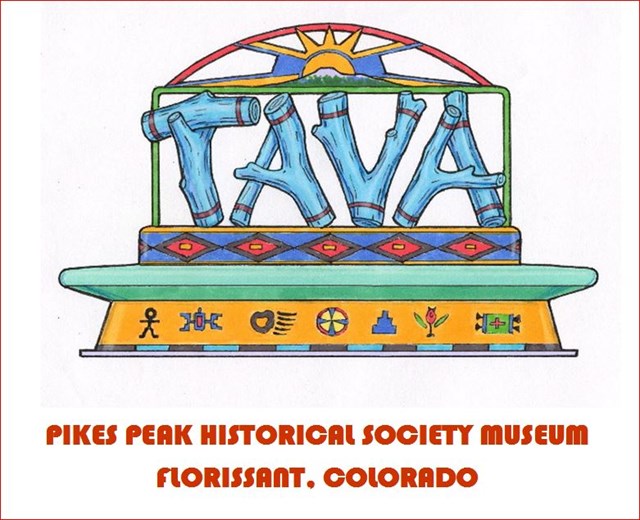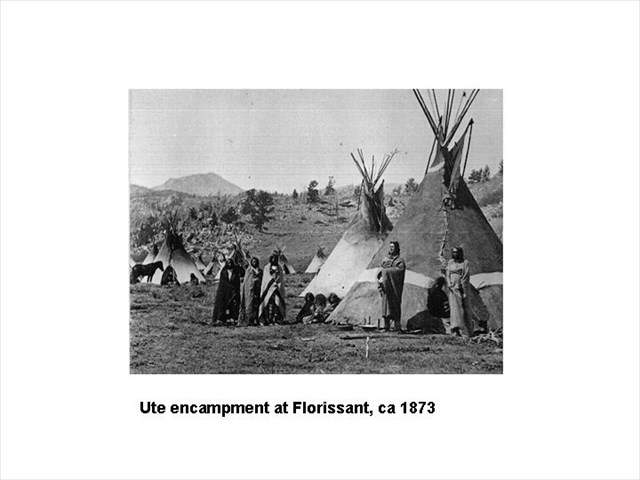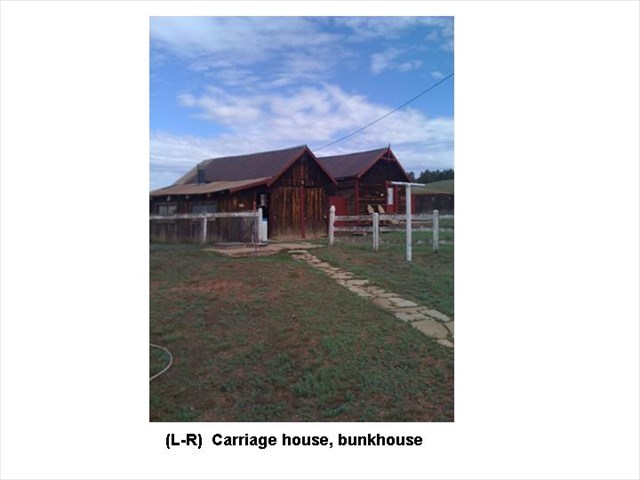

Twin Creek Ranch is listed on the National Historic Register of Historic Places. It is a compound consisting of nine historic structures: Trapper’s Cabin, Log Homestead/Barn, Harness Shed, Bunkhouse, Outhouse, Carriage House, Victorian House, and two Potato Cellars.
TIPI LODGE POLES:
In the pasture northwest of the barn, leaning against a pine tree, two very old Indian lodge poles were found. These, coupled with dozens of stone tools found in the pastures, provide tangible evidence of the first inhabitants of the region – Ute Indians. [These stone tools are now on display at the Pikes Peak Historical Society Museum in Florissant.] The region from east of Colorado Springs, west to the border of Utah, and from I-70 down to Ft. Garland was the traditional territory of the Tabeguache Band of the Ute. Chief Ouray, Piah, and Colorow were frequent visitors to the area. Atlanta Georgia Thompson recalled their visits:
"The [Ute] Indians were all through the country and some big camps were located near our place [now the Florissant Fossil Beds National Monument]. Those camps were very interesting to all of us because they were so different from the white man’s camp. They were very colorful because every tepee had a figure of a warrior or horse painted on one or both sides of it with the bright red, green, yellow paint that only the Indians know how to make. They usually chose a level place near a little stream where they pitched their tepees and then after the ponies were relieved of their packs, they were turned loose to graze on the mountain grass which was very plentiful… Chief Colorow was in our house many times. He was very friendly toward the white man. He could speak some English, and father enjoyed talking to him. Sometimes he would come and bring some of his tribe with him. They would sit on the floor and say, ‘Heap pretty squaw,’ meaning my mother, and then say, ‘Me like heap biscuits.’ [Daughter of a Pioneer, 1982]"

TRAPPER’S CABIN:
On the Northwest side of the compound is the oldest structure, a Trapper’s Cabin probably built by Kit Carson and his free trappers in the 1840s. Carson and his men trapped the region for valuable beaver pelts during this era, and his last known foray here was in 1852. The date of the cabin was established by an archaeologist with the National Park Service, and the connection with Carson was established by a visit from his grandson, John Carson, in the early 1990s when he was doing an inventory of Carson’s cabins in the area. All of Carson’s trapper cabins exhibit the same dimensions, and have doors and windows opening to the south.
In his book Thirty One Years on the Plains and In the Mountains, Will Drannan writes that Carson brought his young trappers up from Taos by mule train, carrying with them a small wood stove for their cabin. Identical cabins were built in a trapping area approximately five miles apart. Two men would inhabit each cabin, and trap the beaver streams in the area. The trappers would use the skin of a fresh elk kill for a bed after attaching it to the walls of the cabin with pegs.
The first written documentation of the cabin dates to ca 1865, when a mountain man named Frederick Smith provided written testimony on behalf of Thomas Burnham’s homestead application. Burnham acquired the cabin from Smith. In the Pre-Emption Proof for Burnham, Smith states that he “used to live in it [cabin].”
Smith was born in Germany, and immigrated with E. Smith, H. Smith, and Conrad Smith around 1853. He married Minnie Hase prior to immigrating to Platte County, MO. Five years later he enlisted in the U.S. Army, where he served with the 5th Kansas Calvary, Company L during the Civil War. He contracted pneumonia at Camp Blunt, MO in the fall of 1862. Then in 1863, he “incurred chronic diarrhea from bad food and water and exposure” at Camp Shanghai, MO. In November 1864, his wife Minnie passed away. His bad luck continued nonetheless, and Smith suffered for several months from pneumonia. Dr. W.D. Bull advised him to move to Colorado in order to improve his fragile health. When he arrived in Florissant, he worked as a blacksmith and farmed. He remarried Emeline (Huffmann) Baker around 1865 in Kansas. Emmaline’s first husband, Louis Baker, was killed by Quantrill’s Raiders during the Civil War in 1862. She had four children at the time of her marriage to Smith: Ida (age 8), Emma (age 6), Louis (age 5), and Charles (age 2). Frederick Smith entered the Old Soldiers Home in Monte Vista, CO., where he died in April, 1904.
LOG BARN/HOMESTEAD:
Thomas H. Burnham purchased the Trapper’s Cabin from Smith sometime in 1872, and lived there while he built his log homestead – he was only 27. Census records show that Thomas Ham Burnham was born in Bunker Hill, Illinois on Jan 29, 1845, where his father was a farmer. Thomas reported on his homestead documents that his “first act was to build a house to live in…I have built a house, 2 stables, a camp house, a corral and have on it ¾ mile of ditches and have nearly all fenced. Value of improvements $800.” At that time, he stated that he had a wife but no children. Census records show that he married Ella [maiden name unknown] Burnham, also from Illinois.
The beautiful hand-hewn logs bear testament to the fact that there was no sawmill in the area at that time. Some of the logs used are at least 18 inches thick, from old-growth pines. In the 1880 Census, Thomas lists his occupation as “cattle dealer.” A brand found burned into the shed attached to the log homestead features two “s” shaped lines that could indicate “Twin Creek” Ranch. However, there are no Colorado Brand books prior to the 1900s, so this can’t be confirmed. Colorado was open range, so it was common for stock raisers to brand their cattle to facilitate sorting at roundup time.
By the 1885 Census, Thomas and Ella are prosperous enough to have acquired a servant, Murray Sibby (sp?) from Ireland. After the Victorian house was built in 1887, the log homestead was converted to a barn. Some of the original doors and windows were boarded over for this, and a second floor was added for hay storage.
When Burnham filed his Homestead Proof in 1892, he stated that he was a widower. Apparently, sometime after 1887 his wife gave birth to a stillborn child, and in her postpartum depression, she hung herself in the hayloft.
BUNKHOUSE, HARNESS SHED, CARRIAGE HOUSE:

In Burnham’s 1886 Homestead Affidavit, and in Witness Testimony by Frank Castello and Fredrick Smith, he states that he is the head of a family, and that his improvements consist of a 20x24 log house, two one-story stables (6 ft long) [harness shed and carriage house], a storehouse 12 ft x 14 ft (the Trapper’s Cabin), a shed 10 foot-long (bunkhouse).
VICTORIAN HOUSE AND POTATO CELLARS:
In his 1892 Home Stead Proof, he states that he built an 8-room frame house in 1887. His southern pasture includes the rail bed of the Colorado Midland Railroad. He probably built the Victorian house with the right-of-way proceeds from the CMRR. He maintains that he is now a widower. John Wilson and Count Louis Otto de Pourtales provided Witness Testimony for his Proof. Wilson provided the additional information that Burnham planted 6 acres of potatoes every year since 1887. Therefore, we can deduce that he built the potato cellars around 1887. It was profitable for the area homesteaders to provide beef and produce to the miners via the CMRR. Both Wilson and Pourtales stated that Burnham’s land was excellent for raising stock.
SUBSEQUENT OWNERS OF TWIN CREEK RANCH:
Sometime after 1892, Thomas Burnham’s Twin Creek Ranch passed to his older brother, Frank J. Burnham. We can speculate that he fell ill, and transferred ownership. Thomas Burnham passed away on Jan 14, 1900. In 1899, Frank sold the ranch (which was now 2200 acres) to Charles H. Sisler for $2000. Charles continued the ranching operations of Twin Creek Ranch, and registered his brand as “Lazy C” above an “H”, closed by a crescent on the right.
Charles adopted two brothers, Robert and Tom, from an orphanage in Cripple Creek. During the typhoid epidemic, in 1892, the brothers (then 10 and 7 years old) were quarantined in the Trapper’s Cabin, where the both succumbed to the illness. They are buried in the Florissant Pioneer Cemetery.
In 1901, Charles Sisler sold Twin Creek Ranch to Dora M. Allen for “one Dollar and other valuable consideration.” William C. and Dora Allen owned and operated the Florissant Mercantile since 1892, so it is very likely that Sisler used Twin Creek Ranch to grubstake his activities in Cripple Creek. The miner’s registry in Cripple Creek lists Sisler as a miner there during this period. The Allen’s also continued to operate Twin Creek Ranch as a working cattle ranch, and registered their brand as the number “12” over a crescent.
In 1892, William C. Allen bought the Florissant Mercantile and combined it with the post office. The store was called the Florissant Mercantile Company. Allen’s brother, Silas, and his father, William P., owned and operated a Saw Mill near Wilson Lakes, about a mile south of Twin Creek Ranch. (Incidentally, William C. and Silas – the brothers – married sisters, Dora and Flora Dodge.) Dora’s father, Jonathan E. Dodge, Jr., operated the drug department of the store.
The Florissant Mercantile Company had everything from groceries, general merchandise, and furniture in addition to drugs and the post office. In the back of the store there was farm machinery of every kind. A set of wagon scales was installed in front of the store sometime between 1919 and 1923. The Mercantile was in service for forty-four years. William C. also served as justice of the peace for Florissant. In the late 1880s, William C. had an accident with his horse, when it fell, pinning him underneath. His leg was crushed, and blood poisoning set in so that the leg had to be amputated. His neighbor, Atlanta Georgia Thompson remembered the event in her book Daughter of a Pioneer:
"While I was in bed [her leg had just been amputated, ca 1887] a young man by the name of Will Allen came to see me and asked me if I was taking morphine and I told him that I had taken it, that I thought it had saved my life and he said, ‘Well, they could cut all my arms and legs off and I would never take it again.’ He could sympathize with me perhaps more than the rest of my friends or family because about five years before a horse had fallen on him and crushed his foot. He was from a ranch about three miles west of Florissant and about twelve miles from our place [Silas Thompson ranch, Divide]. His aunt, a physician from California, happened to be visiting his people. They were on their way to Colorado Springs to have his foot taken care of and arrived at our little ‘life saving station’ about twelve o’clock at night. His father was driving the team, and his aunt was in the wagon taking care of him. They stopped at our house to see if we had room for them and when we assured them we would make room the aunt decided to send on to Manitou and have another doctor come up there. Silas got one of the hired men up and sent him on horseback after the doctor. The next morning when the doctor arrived, he said there was nothing to do but to take the leg off. The doctors did this at our house and the very next day they made Will a bed in the wagon and took him to Manitou. After he had been there a few days, the doctors took some more of his leg off. If he had not been well and strong, he could not have stood it."
You can still feel the indentation made by William’s wooden leg in the doorway to the dining room at Twin Creek Ranch. After William’s death in 1936, his sons, William E. and Clyde continued to operate the ranch for their mother. In 1946, Dora M. Allen sold the ranch to Alexander C. Kirk. She passed away in 1958.
Kirk was the wealthy heir to Kirk’s Castile Soap, and had an illustrious career in the United States Diplomatic Service. After the war, Kirk’s health was in decline, and he came to Colorado to die. However, the altitude and mountain air healed him, and he poured all of his energies into his new ranch. His former State Department aide, Albert W. Horn, was again his trusted assistant. Together, they oversaw the building of 58,195 feet of diversion ditches, 72,781 feet of terraces, and 5,350 drainage ditches. He had his cowboys fill their saddle bags with hardy grass seed from Kenya and spread it as they herded his prized Angus cows. In 1950, he had flown to California and bought his breeding stock of one bull and five cows for $360,000, then chartered an airplane to fly them to the ranch. In a few years, he had 250 pedigreed head wearing his “Bar K Reverse K” brand. Always a bit of a dandy, Kirk included the brand on his car, his shirts, his suits – everywhere. He was known to dress impeccably in his monogrammed shirts and three-piece, Italian suits. Always. No matter what work he was doing. His money, his fame, and his élan earned him the affections of Marlene Dietrich, who called him “one of the most fascinating men” she knew. Kirk’s mother, however, took a dim view of his romance with an actress, and reportedly made an undisclosed financial enticement so that she would “leave her son alone.” Kirk remained a bachelor until his death in 1979.
By 1954, Kirk was unable to pay the taxes on his ranch [which now covered almost 20,000 acres] and transferred it to A.W. Gregg in exchange for some “worthless” land in Arizona – where he struck oil. He left behind his trusted foreman, Anatole [last name unknown]. Anatole continued to work for Gregg until sometime in the 1960s. Local cowboys tell of a heated argument between the two, when Gregg fatally wounded Anatole in a shootout on the second floor of the Victorian house. He wrapped the wounded Anatole in a blanket, and buried him alive in the basement. The bullet hole can still be seen on the second floor landing.
Around 1979, Gregg sold Twin Creek Ranch to Nicholas M. Buttera, who then sold it to Elier C. and Edith Ann Roqueta. In 1986, Roqueta’s transferred ownership to Argie S. McElmurry, but ownership returned it to them in 1986. Finally, in 1988, Harold and Celinda Kaelin purchased Twin Creek Ranch from the Roquetas. The Kaelin’s also have continued the cattle raising tradition of Twin Creek Ranch, and registered their brand as “TSSR.”